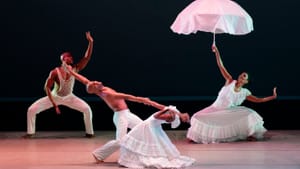Stay in the Loop
BSR publishes on a weekly schedule, with an email newsletter every Wednesday and Thursday morning. There’s no paywall, and subscribing is always free.
Dancing in memoriam
Alvin Ailey American Dance Company returns to the Academy of Music

The Academy of Music was packed to the amphitheater on Friday, February 28, for Alvin Ailey American Dance Company, their first visit since the November death of former artistic director and Ailey muse Judith Jamison. Jamison on television, dancing Ailey’s Revelations with a big, white umbrella, opened up a whole world for me before I’d ever seen a live modern dance performance. She remains my ideal of a dancer, and when I think of her, it is her great leg extensions in that white ruffled skirt in Ailey’s Cry. Entering the theater, I knew that Jamison must be on all of our minds, and I wondered how the company would acknowledge her legacy. Fittingly, they did it with Cry.
The Jamison legacy
Ailey created Cry in 1971 as a solo piece for his mother’s birthday and maybe a bit for Jamison as well. We had a small sample of the piece danced by Jacquelin Harris, Samantha Figgins, and Caroline T. Dartey in those memorable white leotards and ruffled white skirts (by designer A. Christina Giannini). Each woman performed a short bit of the solo and then came together in a trio that spun across the stage, their skirts flaring out like flowers. Chuck Griffin’s “Right on, Be Free” set a frenetic pace with the call-out, “Mother, save your child” (vocals by the Voices of East Harlem). The leg extensions were all you would expect of Ailey dancers: dramatic in those ruffled skirts. It felt as if the spirit of Jamison herself was dancing with them—and yes, I did, in fact, get a bit teary.
Revelations followed, and the memories came with it, of Jamison with that big white umbrella, crossing a river of rippling fabric stretched across the stage. The piece is a mainstay of Ailey tours, and each time I find something different to love. This year, the men—James Gilmer, Chalvar Monteiro, and De’Anthony Vaughan—were jaw-dropping as they leaped across the stage to “Sinner Man,” against a fiery backdrop (by lighting designer Nicola Cernovitch).
I’ve been asked whether it must get tiresome to dance this piece so often, but Revelations is more than just another work in the repertoire. No other piece in the repertoire embraces its community so thoroughly, and that sense of community shone through in the finale. The company, women in their long yellow dresses and fans, and men in their natty black pants and gold-fronted vests, seemed to live their dancing. The men in particular were sharp and snappy, with chests out and pride glowing from their faces. Today as in the 1960s when the piece was new, pride is a political act.
Before we reached the Jamison tribute in the second half, the show opened with a new production of Ronald K. Brown’s Grace. Brown created the piece for the December 1999 gala on the 10th anniversary of Ailey’s death. It mixes spirituals, house, and African music from Duke Ellington’s “Come Sunday” to Fela Kuti’s Shakara in a fast-paced combination of dance styles: high knees and butterfly legs, but also contemporary leaps. The men, in red or white scrunched pants, were particularly impressive, whether leaping across the stage or with leg extensions with up-bent feet danced in unison.
The strength in freedom
But the star of the first half was the premier of Hope Boykin’s Finding Free, which, she has said, is not about removing all the obstacles to freedom but finding the strength to carry the burden and still be free. I have felt lately that Boykin seemed to be repeating herself, but Finding Free shook that off in a work notable not only for the innovative choreography but for the synergy of all its parts. Boykin collaborated closely with composer Matthew Whitaker to create an eerie soundscape, and she designed the costumes with Jon Taylor. The first act gave us the company in bulky coats with high collars, moving about the stage in a tight group with short, quick steps. I am not a fan of mist, but it was used brilliantly here by lighting designer Al Crawford. It roiled like storm clouds and, swept with lights, could have been a sand-blown desert at their feet.
In the second act, the dancers shed the confining coats and moved more freely, but were still encumbered by folds of grey skirts and tops. In the third, they cast off the heavy skirts for long filmy tunics in pale pastels. The music shifted to the sound of a church organ and beams of light seemed to shine through a stained-glass window. The choreography felt like praise dancing, with uplifted arms or lift after jubilant lift. As Boykin explained, freedom doesn’t free you of all your burdens, it’s having the strength to carry them.
On Saturday evening and Sunday afternoon, audiences saw Matthew Rushing’s Sacred Songs and Lar Lubovitch’s Many Angels with Revelations.
What, When, Where
Alvin Ailey American Dance Theater. Choreography by Hope Boykin, Ronald K. Brown, Alvin Ailey, Matthew Rushing, and Lar Lubovitch. Presented by Ensemble Arts Philly. $29-$90. February 28 through March 2, 2025, at the Academy of Music, 240 S Broad Street, Philadelphia. (215) 893- 1999 or ensembleartsphilly.org.
Accessibility
See accessibility and accommodations for the Academy of Music online.
Sign up for our newsletter
All of the week's new articles, all in one place. Sign up for the free weekly BSR newsletters, and don't miss a conversation.

 Camille Bacon-Smith
Camille Bacon-Smith